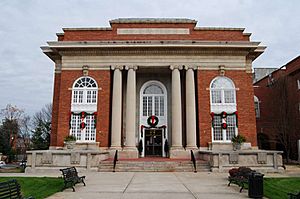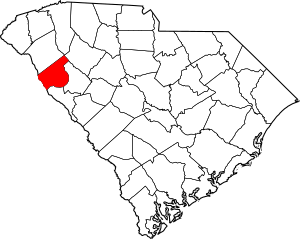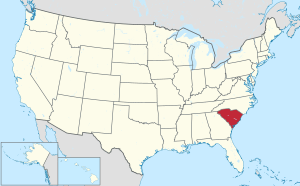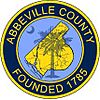Abbeville County, South Carolina facts for kids
Quick facts for kids
Abbeville County
|
||
|---|---|---|

|
||
|
||
| Motto(s):
"A Great Place to Live."
|
||

Location within the U.S. state of South Carolina
|
||
 South Carolina's location within the U.S. |
||
| Country | ||
| State | ||
| Founded | 1785 | |
| Named for | Abbeville, France | |
| Seat | Abbeville | |
| Largest community | Abbeville | |
| Area | ||
| • Total | 511.74 sq mi (1,325.4 km2) | |
| • Land | 491.19 sq mi (1,272.2 km2) | |
| • Water | 20.55 sq mi (53.2 km2) 4.02% | |
| Population
(2020)
|
||
| • Total | 24,295 | |
| • Estimate
(2023)
|
24,434 | |
| • Density | 49.46/sq mi (19.10/km2) | |
| Time zone | UTC−5 (Eastern) | |
| • Summer (DST) | UTC−4 (EDT) | |
| Congressional district | 3rd | |
Abbeville County is a county in the state of South Carolina. A county is like a smaller region within a state. In 2020, about 24,295 people lived here.
The main town, or county seat, is called Abbeville. This county is special because it's the first one in the United States when you list them alphabetically! Abbeville County is part of a larger area known as the Upstate or Upcountry.
History
Both Abbeville County and its main town, Abbeville, got their names from a town in Abbeville, France. An early settler came from there. The county was officially created in 1785. Later, parts of it were used to form Greenwood and McCormick counties. Many Scotch-Irish and French-Huguenot farmers settled here in the mid-1700s.
A very important agreement, the Treaty of Dewitt's Corner, was signed here. This treaty was a peace talk with the Cherokee Native Americans. It happened in a place now called Due West. After the treaty, the Cherokee tribe split into two groups. One group, the Chickamauga Cherokee, kept fighting settlers for 30 more years.
Abbeville County was a strong supporter of leaving the United States before the Civil War. This idea was called secession. It was also where the last meeting of the Confederate leaders happened during the war.
In 1950, about 22,456 people lived in Abbeville County. By 2020, the population had grown to 24,295 people.
Geography
Abbeville County covers about 511.74 square miles. Most of this area, about 491.19 square miles, is land. The rest, about 20.55 square miles, is water. This means about 4% of the county is water. The county is located in the areas where the Savannah River and Saluda River flow.
National protected area
- Sumter National Forest (part of it is in Abbeville County)
State and local protected areas/sites
- Calhoun Falls State Park
- Cedar Springs Historic District
- Long Cane Scenic Area
- McCalla Wildlife Management Area
Major water bodies
Adjacent counties
Abbeville County shares borders with these other counties:
- Greenville County – to the north
- Anderson County – to the north
- Laurens County – to the northeast
- Greenwood County – to the east
- McCormick County – to the southeast
- Elbert County, Georgia – to the west
Major highways

 US 25 Bus.
US 25 Bus. US 178
US 178 SC 20
SC 20


 SC 20 Conn.
SC 20 Conn. SC 28
SC 28


 SC 28 Conn.
SC 28 Conn. SC 71
SC 71


 SC 71 Truck
SC 71 Truck SC 72
SC 72 SC 81
SC 81 SC 184
SC 184 SC 185
SC 185 SC 203
SC 203


 SC 203 Truck
SC 203 Truck SC 284
SC 284
Demographics
| Historical population | |||
|---|---|---|---|
| Census | Pop. | %± | |
| 1790 | 9,197 | — | |
| 1800 | 13,553 | 47.4% | |
| 1810 | 21,156 | 56.1% | |
| 1820 | 23,167 | 9.5% | |
| 1830 | 28,149 | 21.5% | |
| 1840 | 29,351 | 4.3% | |
| 1850 | 32,318 | 10.1% | |
| 1860 | 32,385 | 0.2% | |
| 1870 | 31,129 | −3.9% | |
| 1880 | 40,815 | 31.1% | |
| 1890 | 46,854 | 14.8% | |
| 1900 | 33,400 | −28.7% | |
| 1910 | 34,804 | 4.2% | |
| 1920 | 27,139 | −22.0% | |
| 1930 | 23,323 | −14.1% | |
| 1940 | 22,931 | −1.7% | |
| 1950 | 22,456 | −2.1% | |
| 1960 | 21,417 | −4.6% | |
| 1970 | 21,112 | −1.4% | |
| 1980 | 22,627 | 7.2% | |
| 1990 | 23,862 | 5.5% | |
| 2000 | 26,167 | 9.7% | |
| 2010 | 25,417 | −2.9% | |
| 2020 | 24,295 | −4.4% | |
| 2023 (est.) | 24,434 | −3.9% | |
| U.S. Decennial Census 1790–1960 1900–1990 1990–2000 2010 2020 |
|||
2020 census
A census is a count of the population. In 2020, there were 24,295 people living in Abbeville County. There were 9,660 households (groups of people living together) and 6,248 families.
| Race | Num. | Perc. |
|---|---|---|
| White (not Hispanic) | 16,744 | 68.92% |
| Black or African American (not Hispanic) | 6,184 | 25.45% |
| Native American | 44 | 0.18% |
| Asian | 71 | 0.29% |
| Pacific Islander | 7 | 0.03% |
| Other/Mixed | 822 | 3.38% |
| Hispanic or Latino | 423 | 1.74% |
2010 census
In 2010, there were 25,417 people in the county. The average age was 41.6 years old. The average income for a household was about $33,143 per year.
Economy
In 1999, Abbeville County was very successful at creating new jobs. This was partly because electricity costs were low. Also, there are "right-to-work laws" which can affect labor costs. The county also offers special training for workers through Piedmont Technical College.
In 2023 and early 2024, the number of people without jobs (unemployment rate) was around 4%. In 2022, the total value of all goods and services produced in Abbeville County (called GDP) was about $666.9 million. This means about $27,450 per person.
Some of the biggest employers in Abbeville County include the city of Abbeville, Erskine College, Hardee's, Ingles, Prysmian Group, Sage Automotive Interiors, and Wayfair.
| Industry | Number of Jobs | Job Percentage (%) | Average Yearly Pay ($) |
|---|---|---|---|
| Hotels and Restaurants | 337 | 6.5 | 16,380 |
| Office Support and Waste Services | 223 | 4.3 | 35,880 |
| Farming, Forests, Fishing, and Hunting | 35 | 0.7 | 31,200 |
| Construction | 127 | 2.4 | 46,800 |
| Education | 683 | 13.1 | 41,028 |
| Money and Insurance | 75 | 1.4 | 49,504 |
| Health Care and Social Help | 484 | 9.3 | 59,072 |
| Information (like media) | 122 | 2.3 | 78,000 |
| Manufacturing (making things) | 1,784 | 34.3 | 62,036 |
| Other Services (not government) | 96 | 1.8 | 35,724 |
| Science and Technical Services | 111 | 2.1 | 101,660 |
| Government Jobs | 478 | 9.2 | 42,588 |
| Real Estate and Rentals | 14 | 0.3 | 36,504 |
| Retail Stores | 439 | 8.4 | 21,788 |
| Transportation and Storage | 65 | 1.3 | 55,380 |
| Utilities (like power) | 47 | 0.9 | 80,860 |
| Wholesale Trade | 77 | 1.5 | 62,660 |
| Total | 5,197 | 100.0% | 49,729 |
Education
Abbeville County has two main school districts. Most schools are part of the Abbeville County School District. Some parts of the county are in the Greenwood School District 51.
Schools in Abbeville County School District
- Abbeville County Adult Education
- Abbeville High School (grades 9–12)
- Abbeville County Career Center (offers extra job training for grades 10–12)
- Cherokee Trail Elementary (grades K–7)
- Diamond Hill Elementary (grades K–7)
- Dixie High School (grades 8–12)
- John C. Calhoun Elementary (grades K-5)
- Long Cane Primary (grades K–2)
- Westwood Elementary (grades 3–5)
- Wright Middle School (grades 6–8)
Other schools
- Calhoun Falls Charter School (students from anywhere in the state can attend)
Colleges and universities
- Erskine College: This is a four-year Christian college in Due West, South Carolina. It has about 575 college students.
- Piedmont Technical College: This college has a campus in Abbeville, SC.
Communities
City
- Abbeville (This is the county seat and the largest community.)
Towns
- Calhoun Falls
- Donalds
- Due West
- Honea Path (mostly in Anderson County)
- Lowndesville
- Ware Shoals (mostly in Greenwood County; partly in Laurens County)
Census-designated places
These are areas that are like towns but not officially incorporated.
Notable people

Many important people have come from Abbeville County:
- John C. Calhoun (1782–1850): Born in the Abbeville area, he was a U.S. congressman and U.S. senator for South Carolina. He also served as Secretary of War, Secretary of State, and Vice President of the United States.
- Langdon Cheves (1776–1857): Born in Abbeville County, he was a banker and a U.S. congressman.
- Francis Alanson Cunningham (1804–1864): Born in the Abbeville area, he was a doctor and a U.S. Congressman from Ohio.
- Leomont Evans (born 1974): A former American football player in the NFL.
- Joshua Hill (1812–1891): Born in the Abbeville area, he became a U.S. senator from Georgia.
- Thomas D. Howie (1908–1944): An American army officer who died during World War II. He was known as "The Major of St. Lo."
- Abner Smith Lipscomb (1816–1890): Born in the Abbeville area, he was a judge for the Supreme Court in both Alabama and Texas.
- James L. Petigru (1789–1863): Born in the Abbeville area, he was the chief lawyer for South Carolina and a member of the state's House of Representatives.
See also
 In Spanish: Condado de Abbeville para niños
In Spanish: Condado de Abbeville para niños


